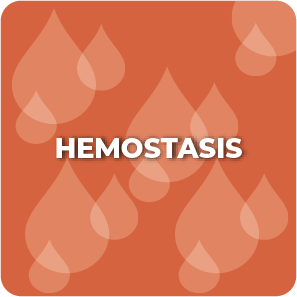



Hemostasis and bleeding disorders
Mecanism of Hemostasis
Hemostasis is the process that stops blood loss from a damaged vessel and is a dynamic balance between two competing forces: anti-coagulation and pro-coagulation. Hemostasis can be subdivided into three sequential processes:
Primary hemostasis
Interaction of the injured endothelium with von Willebrand factor (VWF), and platelets is crucial for the formation of a platelet plug at the injury site.
Secondary hemostasis
Coagulation factors are activated on the surface of injured endothelium and activated platelets, which ultimately form a fibrin mesh that stabilizes the platelet plug to allow wound healing.
Tertiary hemostasis
Fibrinolysis is activated to dissolve the platelet plug and return the normal architecture of the endothelium, smooth endothelial lining, and normal lumen size.
Bleeding or coagulation disorders
Disorders of hemostasis or unbalanced hemostasis may lead to hypocoagulation (hemorrhage) or hypercoagulation (thromboembolic disorders). Hereditary bleeding disorders occur due to the absence or deficiency of specific clotting proteins. The most common hereditary bleeding disorders are hemophilia A, hemophilia B, von Willebrand disease, immune thrombocytopania (ITP).
Advances and innovation in treatment of Hemophilia
Hemostasis has now been widely studied for more than a century. Life science research has generated a very detailed picture of the molecular and cellular events that play roles in normal and pathological hemostasis. Novel medication for treatment of hemostatic disorders is still a significant area of interest, taking hemophilia treatment as an example.
Explore the latest programmes to support your clinical decision-making.



